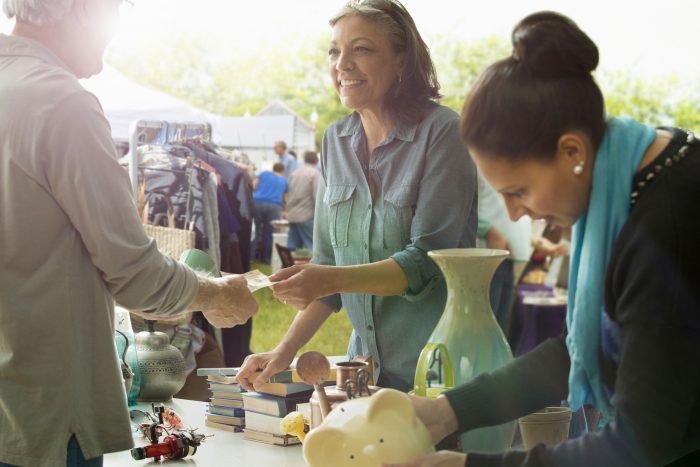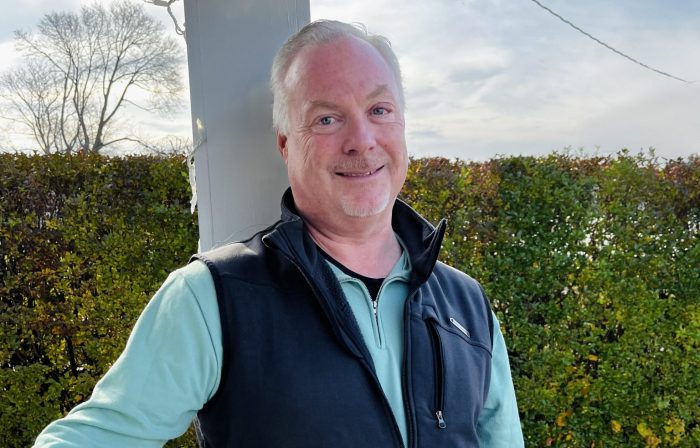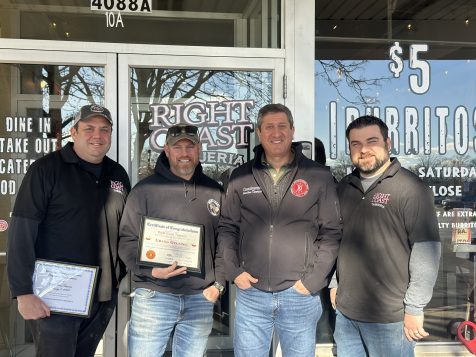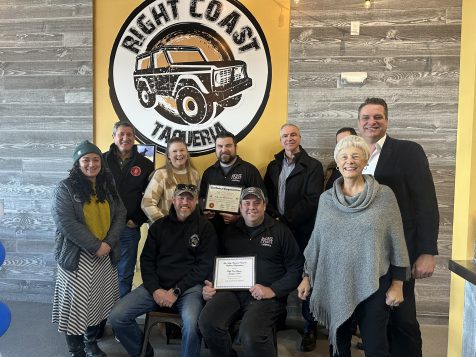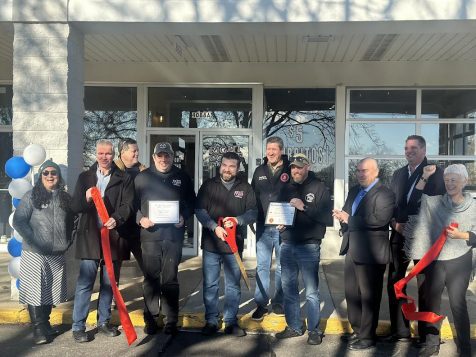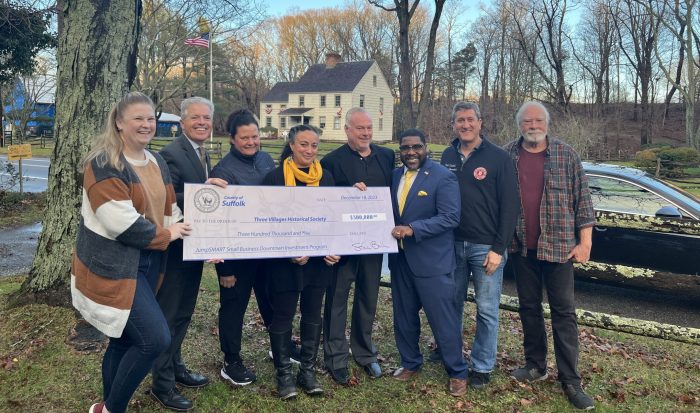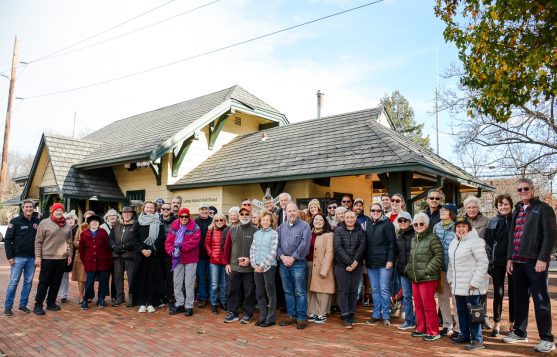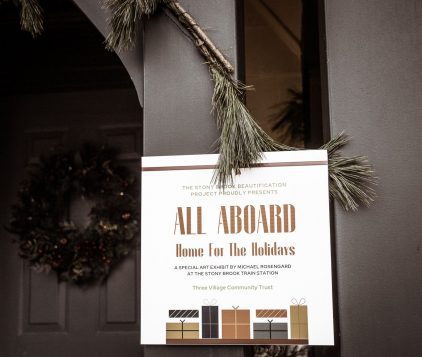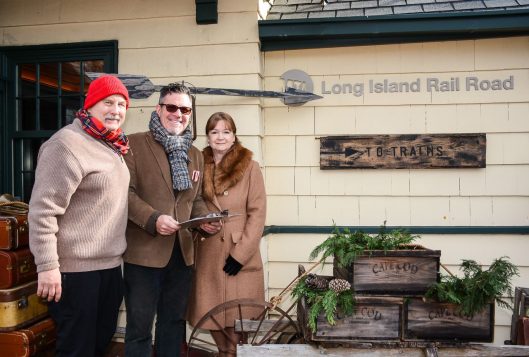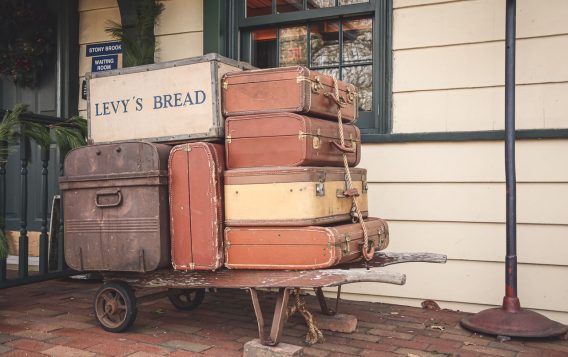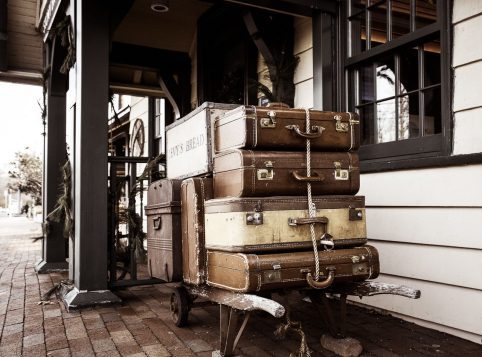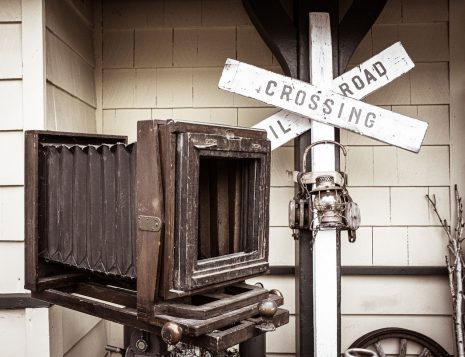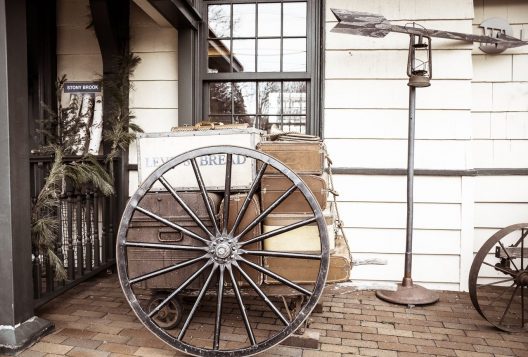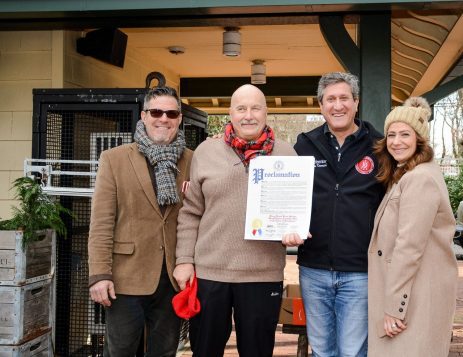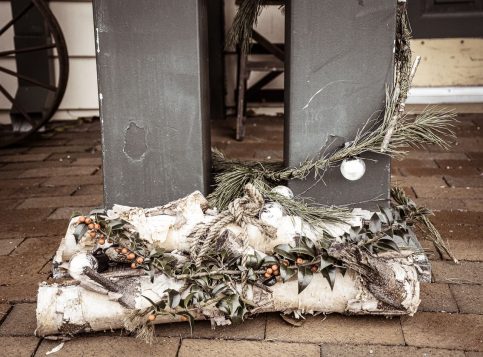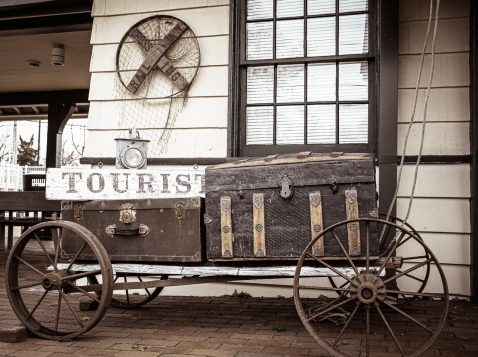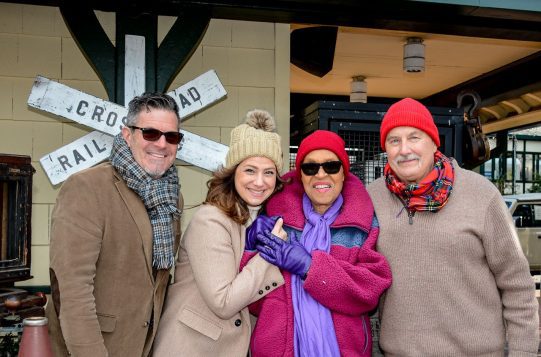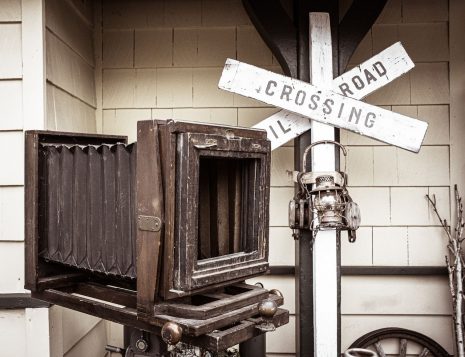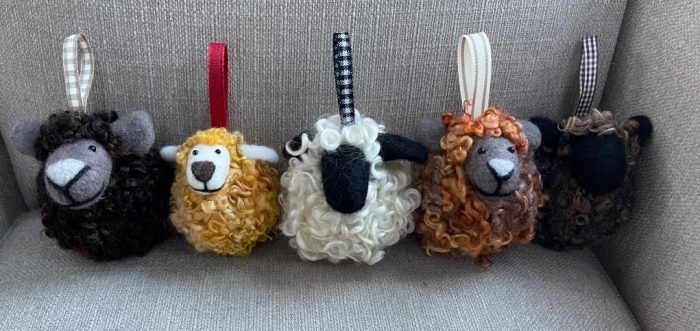Three Village Historical Society
TVHS celebrates 60th anniversary with relaunch of Historic House Marker program
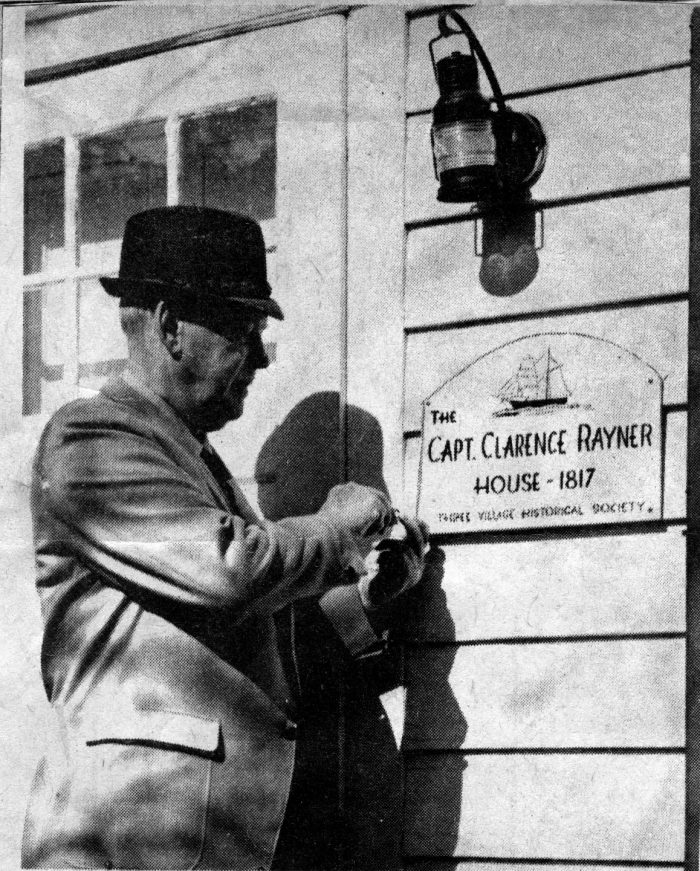
By Kimberly Phyfe
As you travel throughout the Three Village area, you might notice houses quietly boasting white signs with blue writing on them. These markers are adorned with Setauket-built sloop The Daisy and perhaps the names of original home owners. They are an indication that something special is happening here, and it’s about to get even better!
Sixty years ago, one of the first projects the Three Village Historical Society (TVHS) took on was marking the homes of ship captains and ship builders in the Three Village area. To commemorate their 60th anniversary, they are embarking on a new leg of that journey with the re-imagined Historic House Marker program — and everyone is invited!
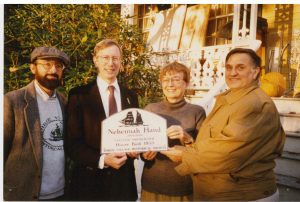
“In honoring six decades of dedication, reflection, and growth, we commence an initiative close to our hearts: ’60 for 60.’ This updated version serves as a revival of our esteemed Historical House Markers program, a pioneering endeavor initiated by Captain Rhodes, a founding member of our Society,” says TVHS Director Mari Irizarry. “The Historical House Markers program pays tribute to the cherished residences, remarkable individuals, and pivotal events that have shaped the very fabric of our community over centuries. Each marker unveiled becomes a beacon of remembrance, a testament to the resilience and spirit of those who came before us.”
This is not only the first project undertaken by the Three Village Historical Society back in 1964, but it reflects what the Society considers one of its most important ideas, that “it regards the entire Three Village area as its museum; the homes, the people and the natural environment as its collection; and the homeowners as its curators.” (Three Village Guidebook, 1986)
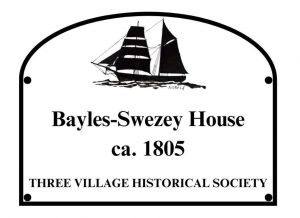
Scott Ferrara, Exhibits & Collections Coordinator at TVHS, is leading the committee on the revamping of the Historic House Marker program. He noted that “if you drive around the Three Village area, you see a lot of historic homes. However, only some are marked with the iconic white historic house marker, but even those are sun-faded, have cracked paint, and are well worn. They need to be updated and replaced. It’s about time this program is revived. This committee has been formed to bring back this program and offer updated information and materials to the stewards of historical homes in the area.”
Ferrara says that the program will also include research packets about each of the homes, digital and printed copies of the findings, and photographs, deeds, or documents pertaining to the property found in the TVHS archives. The Society is also happy to teach willing home owners how to do research on their own, and what resources are available to them to find out more about the historic houses they live in.
Why empower home owners to do their own digging? TVHS Historian Beverly C. Tyler believes “many homeowners in the Three Village community are ready to embrace the idea that they are — together with many others — the curators of their homes, and that they wish to understand everything that gives their home its special significance.”
TVHS Education Coordinator Lindsey Steward-Goldberg “hopes this new version of the program will continue to inspire owners of historic houses to learn more about not only the history of their house but also how that history of the house fits into the historic narrative of Three Village as a whole.”
Perhaps best known as the birthplace of the Culper Spy Ring and the heart of the Washington Spy Trail, the Three Villages are a popular destination both for tourists and local Long Islanders looking to connect to their roots. Margo Arceri of Tri-Spy Tours uses the homes with historic markers as a reference point on her walking, biking, and kayak tours throughout the area. Arceri loves the fact that “since our town was founded in 1655, there was at last count over 75 pre-Revolutionary homes still in existence in the Three Village area. That’s an incredibly special part of our story that not many other places can say. Our community is full of homes belonging to spies, ship builders, philanthropists, educators, and business owners — those are the true artifacts of our living museum!”
So why is the Society bringing back the Historic House Marker program now? Tyler is determined that “while celebrating the Society’s 60th anniversary, there is no better time to work within the community to emphasize the importance of maintaining and celebrating the homes in the Three Village area which make a significant contribution to the quality of life here.”
There are a few simple qualifications such as: the house must be at least 60 years old and be connected to an historic event or an individual, or have architectural significance. Starting April 1, home owners can see if their houses are eligible with a quick screening on the Society’s website: www.tvhs.org
Irizarry hopes to get at least 60 historic homes to qualify for the markers this year. “As we embark on this journey of reflection and celebration, we invite our community to join us in commemorating this significant milestone. Together, let us honor our past, celebrate our present, and pave the way for a future rich in history and heritage.”
Author Kimberly Phyfe is the Communications Engagement Manager at the Three Village Historical Society.
TVHS takes teatime on the road, starting with the history of chocolate
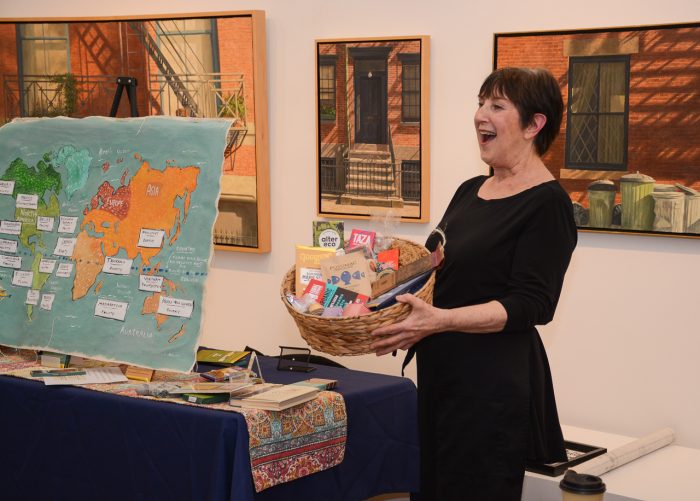
By Mallie Jane Kim
Do you scarf chocolate or savor it? According to chocolatier Linda Johnson, tasting chocolate is akin to tasting wine: Take small bites and let the flavor develop in your mouth.
“That started for me 10 years ago when I would see people just pack chocolate into their mouth and swallow it and say, ‘Oh, that was good,’” Johnson told the 30 attendees at a Three Village Historical Society tea hosted by the Reboli Center for Art and History in Stony Brook on March 11. “I was like, ‘Wait a minute, it took me two days to make that.’”
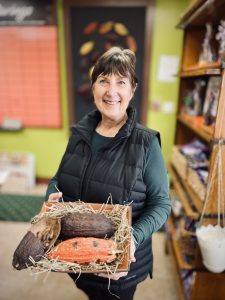
In the sunlit art-lined Reboli Center, Johnson, who owns Chocology in Stony Brook, shared that her appreciation of chocolate springs from her knowledge of cacao’s rich history, from its position as a sacred tree and a currency among the Mayan and Aztec people through its evolution as a sweetened treat in Europe and to the “bean to bar” movement toward quality ingredients and good, child-labor-free processing today. She punctuated her presentation with delicious tastes of various high-quality chocolates from around the world.
Tea with a Spot of History has traditionally been held in the historical society’s cozy circa 1805 homestead on North Country Road in East Setauket, but according to TVHS community engagement manager Kimberly Phyfe, taking the event on the road allows for more attendees and solidifies partnerships among aligned organizations around the Three Village area.
“Going on the road is a win-win-win,” Phyfe said. “It’s a win for us as the historical society, for our community partners and also for our presenters.”
Phyfe pointed out that several attendees were hearing about Johnson’s shop for the first time, and also that many people were browsing and making purchases from the Reboli Center gift shop.
“Everybody wins, and that’s what we’re about,” Phyfe said. “We look at the whole community as our living museum.”
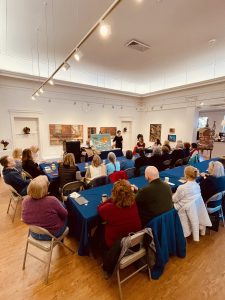
For its next on-the-road installment, Tea with a Spot of History will visit The Long Island Museum on April 5 to celebrate the history of quilting with the Smithtown Stitchers, and Phyfe said she is in talks with other area venues to secure two other teas to round out the spring.
The tea events, in contrast with the more formal lecture series THVS holds at The Setauket Neighborhood House, are a chance for people to sit elbow to elbow, learn a bit of history interactively — and with some tasty treats. Phyfe said the teas used to draw mainly retirees, but have started to also attract others looking for “bite-sized infotainment” during a weekday, from stay-at-home parents to remote workers to those who are able to take a long lunch.
One attendee, Bianca Dresch of Stony Brook, volunteers for TVHS with her husband Dan, but can’t usually attend weekday activities due to work. Both found this event irresistible. “I try to attend whenever something grabs our attention — I saw this combination with the chocolate and Reboli, and I thought, ‘Oh, we’ve got to do this,’” she said.
Teagoer Bonnie Dunbar of East Setauket does usually attend the teas and found the new venue refreshing: “It’s a nice way to get to know what’s around the neighborhood.”
Dunbar said the event piqued her interest in the history of chocolate, and she would have preferred to focus even more on that history. As for the tasters? Those left her satisfied.
“I like the idea of putting the chocolate on your tongue and letting it melt, instead of gobbling it down like I usually do when I eat chocolate,” she said.
Three Village Historical Society welcomes 2024 board of trustees
Last week, the Three Village Historical Society (TVHS) celebrated the inauguration of its 2024 board of trustees with a swearing-in ceremony. The event, held on Tuesday, February 13th, marked the official introduction of the newly appointed leadership team.
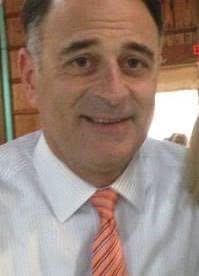
Greg Philipps, assuming the role of president, and Bob Lauto, taking on the position of vice president, were both sworn in during the ceremony. The honor of administering the oath fell to Fred Bryant, a respected longtime member and former trustee of the Society.
Mari Irizarry, Director of the society, expressed enthusiasm for the new trustees, citing their diverse backgrounds and wealth of experience. She underscored their capacity to provide strong leadership and varied perspectives crucial for addressing the significant challenges and opportunities facing the organization in the coming year.
“As we welcome Greg Philipps and Bob Lauto to their respective roles, we are invigorated by the fresh energy and expertise they bring to our board,” remarked Irizarry. “Their appointment enhances our ability to navigate the complex landscape ahead, ensuring that we uphold our commitment to excellence in education and community-based programming.”
Three Village Historical Society to recommence Dominick-Crawford Barn construction
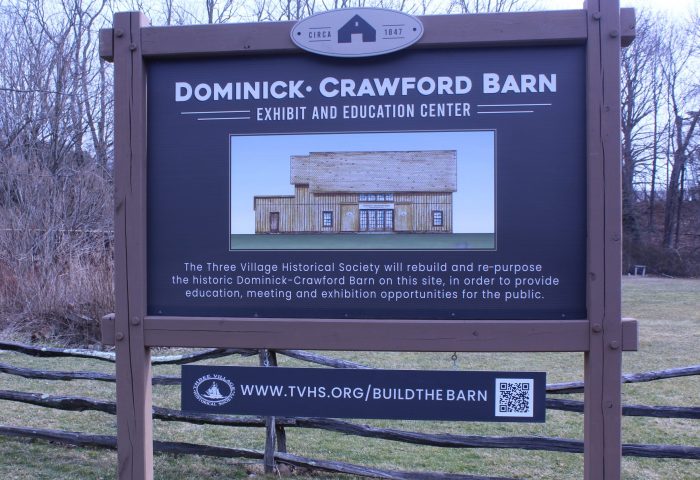
By Mallie Jane Kim
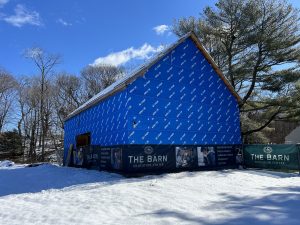 Setauket’s historic district shouldn’t be marked by a bright-blue-wrapped, half-finished barn for much longer, as the Three Village Historical Society plans to start working in earnest on the Dominick-Crawford Barn Education and History Center just as soon as the weather thaws and their supply orders come in.
Setauket’s historic district shouldn’t be marked by a bright-blue-wrapped, half-finished barn for much longer, as the Three Village Historical Society plans to start working in earnest on the Dominick-Crawford Barn Education and History Center just as soon as the weather thaws and their supply orders come in.
“You’re going to see a lot going on in the spring,” said Steve Hintze, who has been on the TVHS barn committee since its inception. “We ran into roadblocks, which seems to be par for the course, but now we’re ready and have everything set to really start moving.”
The society raised the barn exterior quickly last year, only to stall in the fall due to design changes that needed assessment by the Historic District Advisory Committee, a citizen group appointed by Brookhaven Town Board to advise the planning commissioner on changes in historical districts.
The committee recommended adjustments to the society’s altered plans, including to the spacing of seams on the metal roof as well as to the color of the exterior, according to Hintze, who was TVHS president when the society began the barn process in 2014. Hintze added that some of the proposed changes were due to cost increases after the COVID-19 pandemic. The society moved toward less expensive but still historically-accurate materials, and away from a pricey cedar roof and particular windows that had shot up in cost.
“We had enough money to get everything done before the pandemic,” he said. “Due to the pandemic, the cost doubled — flat out doubled.”
This start-and-stop rhythm has been nothing new to the TVHS barn project, which ran into roadblocks from the beginning. The society took down the original 1840s barn from its location in Old Field in 2014, with plans to use the wood to reconstruct a historic barn structure within a commercial shell that could host exhibits and events. According to Hintze, in the process of seeking permits with the Town of Brookhaven, the society learned their building lacked an appropriate Certificate of Occupancy, an issue he said was left over from the previous owner, and there were several past clerical errors that needed ironing out.
“So once we started the project, we immediately started moving forward and then had to slow down,” Hintze said. “Then we move forward and then slow down. So that was the beginning of the barn taking a while to get accomplished.”
Then in 2022, someone cut and stole some key pieces of the original barn wood — including the longest piece. To solve that, the society has additional same-period wood coming from other places locally and from around New York state.
One design sticking point is whether the society can use the high-density engineered wood LP SmartSide siding on the outside structure, which requires less labor and comes with a 50-year guarantee, or whether they need to use historically-accurate siding material like cedar or pine. Hintze said the society would like to consider long-term costs in maintaining the barn, with a material he said is indistinguishable in appearance from classic wood and far more resistant to bad weather, woodpeckers and other wood-destroying creatures.
But some TVHS board members and members of the HDAC have been hesitant, if not against using the material. Town councilmember Jonathan Kornreich (D-Stony Brook), who is familiar with the arguments for and against LP siding on the barn, explained the hesitancy comes from those concerned about historical accuracy — much like a Model T car club using modern materials to restore historic vehicles.
“If you get leaders in who say, ‘Hey, what if we put a Honda engine in the Model T, or fiberglass siding, or maybe air conditioning to be more comfortable,’ at some point, you’re not the Model T car club anymore,” the councilmember said.
Kornreich added that a decision about siding material is a big deal because Setauket’s historic district is one of the strictest in Suffolk County. If LP is allowed there, the door opens for it to be used in other historical applications.
But that reason is one TVHS leaders see as a possible plus, opening the door for forward-looking materials in historical contexts. “There’s something to be said about the historical society being able to set a standard, if we’re using these other materials, let’s use the very best of it,” explained society director Mari Irizarry. “Solar panels weren’t approved in the historic district for years, and now they are.”
Hintze said any debate surrounding LP siding shouldn’t slow down the barn building, and added that they are open to cedar if that will get the barn project finished. “It’s not structural — it’s the last thing that goes up,” Hintze said. “It really is something that can come down to the wire.”
In the meantime, the $300,000 JumpSMART grant the society recently received from Suffolk County will help move construction forward, and TVHS community engagement manager Kimberly Phyfe is planning to ramp up fundraising efforts in coming months. “We still have a little ways to go in terms of fundraising and grant writing,” she said, adding that she is hoping the barn will be ready to host visitors by the society’s annual Candlelight House Tour this December.
Volunteer Fair heads to Middle Country Public Library’s Selden branch
Middle Country Public Library, 575 Middle Country Road, Selden will host a Venues for Volunteering Fair on Thursday, Feb. 8 from 6 to 8 p.m. Come find out what volunteer opportunities are available in our area and how you can help!
The following organizations are scheduled to be at the event: All American Assisted Living – Coram, Atlantic Marine Conservation Society, Bethel Hobbs Community Farm, Big Brothers, Big Sisters, EAC Chance to Advance, Family Service League Long Term Care Ombudsman Program, Federation of Organizations/Senior Companion Program, Fire Island Light House Preservation Society, Friends of the Middle Country Public Library, Girl Scouts of Suffolk County, Great Strides LI, Kids Need More, Legal Hand, Literacy Suffolk, Inc., Long Island State Veterans Home at Stony Brook, Mercy Haven Inc., Middle Country Public Library, NY Blood Center, Rebuilding Together Long Island, Save-A-Pet Animal Rescue, Selden Fire Department, Suffolk County Police Explorers, Town of Brookhaven Dept. of Environmental Education and the Three Village Historical Society.
No registration required. For more information, call 631-585-9393.
Right Coast Taqueria opens new location in East Setauket
Right Coast Taqueria celebrated the grand opening of its newest location at 4088 Nesconset Highway in East Setauket with a ribbon cutting on Jan. 5.
Brookhaven Town Councilmember Jonathan Kornreich, members of the Three Village Chamber of Commerce and members of the Three Village Historical Society joined owners David Preisler and Richard Zoob along with General Manager John Negrinelli in the celebration.
The business now has four locations throughout Long Island, including Deer Park, Ronkonkoma and Mineola. The restaurant, which was first established in 2018 at its Deer Park location, serves Mexican food including tacos, burritos, nachos, quesadillas, fajitas and much more.
“Right Coast Taqueria had great food and a fun beach vibe, just what we needed on a cold day as we welcomed them to the community. Wishing them the best of luck, now and in the future,” said Councilmember Kornreich.
For more information, call 631-940-8300. To order online, visit www.rightcoasttaqueria.com.
Three Village Historical Society awarded JumpSMART grant
By Samantha Rutt
The Three Village Historical Society was awarded a $300,000 grant, courtesy of the JumpSMART Small Business Downtown Investment Program on Monday afternoon, Dec. 18.
Suffolk County Executive Steve Bellone (D) and other local officials gathered at Gallery North to present the organization with a giant check signifying the donation.
Along with the Three Village Historical Society, the Ward Melville Heritage Organization, LI Music and Entertainment Hall of Fame and Gallery North – Setauket Historic District also received generous grants from the JumpSMART program. The donations’ funding will be used to support downtown revitalization efforts.
“The funding that we’re distributing here is about supporting our downtowns and our cultural institutions that are so important,” Bellone said. “Much of the funding comes out of the award that we received from the federal government — they really are about promoting economic sustainability over the long term, and I can’t think of a better way to do that than investing in our cultural arts and institutions like the ones here.”
‘All Aboard Home — For The Holidays’ art installation opens at the Stony Brook Train Station
The Three Village Community Trust, the Three Village Civic Association, the North Suffolk Garden Club, the Three Village Chamber of Commerce and students and faculty at the Stony Brook School, and the Three Village Historical Society are partners in a Beautification Project at the Stony Brook Train Station. Over the past year, significant progress has been made removing debris, weeds, and invasive plants from the landscaped beds. And a wide variety of Long Island native plants have been added to the landscaped beds.
As part of their ongoing efforts, the Stony Brook Train Station Beautification Committee invited local artist Michael Rosengard to create a unique art installation at the Station titled ‘All Aboard – Home For The Holiday.’ This outdoor work of art, located outside the front entrance of the historic Stony Brook Station House, creates a sense of wonder and whimsy to those walking or driving past the Station, highlights the history and importance of the Long Island Rail Road, celebrates the accomplishments of the Beautification Project, and helps kicks of the Holiday Season.
The community celebrated the opening of the exhibit on Monday, December 4th!
Winter Holiday Market heads to Setauket Neighborhood House on Dec. 10

Time to shop! The historic Setauket Neighborhood House, 95 Main Street, Setauket will transform into a winter wonderland this Sunday, Dec, 10 as the Three Village Historical Society presents an indoor Holiday Market from 11 a.m. to 4 p.m. Over 30 vendors will be on hand including artist, woodworkers, makers, bakers, florists, felters and creators of all kinds offering gifts for everyone on your holiday list in a warm and cozy atmosphere.
Participating vendors include:
Alex Greco Lettering
Ally Liff Designs
AnTiAmy’s Gifts
Contessa’s Designs
Sweet Woodland Farm
Tend Coffee
The Cinnamon Candle
Dara Saol Jewelry
Finest Macarons
Clovis Outdoor Services
Dan McCarthy Wildlife Art
Ewes and Coos Felted
Grateful Bread Microbakery
Inspired Stones
Janet Kurnatowski Studio
Li Li’s Creations
Monika Botanika
OHoney Bee Farm
Old Post Candle Company
Petals, Paper & Thread
Julia Vogelle Pottery
Stormy Garden Soapworks
Sweet Legends Bakeshop
The Granola Plant LLC
The Nautical Arts Workshop
The Pot City
The Spice Cabinet
The Well Fed Family-Pampered Chef
Three Village Historical Society
Tracy Marlowe Jewelry
White Hat Silver
Wolf & Timber
Sweet Melissa’s
Cozy Knots
The Big Cheese
For more information, call 631-751-3730 or visit www.tvhs.org.


